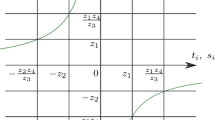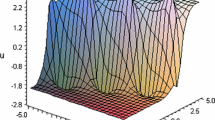Abstract
A generalization of the discrete BKP equation and its Bäcklund transformation equations are investigated. The soliton solution to the generalized discrete BKP equation and the Bäcklund transformation equations is proposed and is proved to satisfy them.
Similar content being viewed by others
References
Hirota, Ryogo: Discrete analog of a generalized toda equation. J. Phys. Soc. Jpn. 50, 3785–3791 (1981)
Miwa, Tetsuji: On Hirota’s difference equations. Proc. Jpn. Acad. Ser. A Math. Sci. 58, 9–12 (1982)
Tsujimoto, Satoshi, Hirota, Ryogo: Pfaffian representation of solutions to the discrete BKP hierarchy in bilinear form. J. Phys. Soc. Jpn. 65, 2797–2806 (1996)
Shinzawa, Nobuhiko: Symmetric linear Bäcklund transformation for discrete BKP and DKP equation. J. Phys. A Math. Gen. 33, 3957–3970 (2000)
Shinzawa, Nobuhiko, Hirota, Ryogo: The Bäcklund transformation equations for the generalized bilinear equation. RIMS Kôkyûroku 1280, 71–75 (2002). (in Japanese)
Takahashi, Daisuke, Satsuma, Junkichi: A soliton cellular automaton. J. Phys. Soc. Jpn. 59, 3514–3519 (1990)
Takahashi, Daisuke, Matsukidaira, Junta: On discrete soliton equations related to cellular automata. Phys. Lett. A 209, 184–188 (1995)
Tokihiro, T., Takahashi, D., Matsukidaira, J., Satsuma, J.: From soliton equations to integrable cellular automata through a limiting procedure. Phys. Rev. Lett. 76, 3247–3250 (1996)
Tokihiro, T., Takahashi, D., Matsukidaira, J.: Box and ball system as a realization of ultradiscrete nonautonomous KP equation. J. Phys. A Math. Gen. 33, 607–619 (2000)
Hirota, R.: The Direct Method in Soliton Theory (Cambridge Tracts in Mathematics), vol. 155. Cambridge University Press, Cambridge (2004)
Acknowledgements
The author would like to express my appreciation to Prof. Ryogo Hirota for constant encouragement and fruitfull discussion.
Author information
Authors and Affiliations
Corresponding author
Pfaffian and its identities
Pfaffian and its identities
In this appendix, we summarise the definition of pfaffians and some identities of it. For a detailed explanation of pfaffians, see [10] for example.
Let us give the definition of pfaffians as follows.
Here, \(1,\ 2,\ \ldots ,\ 2n\) are the indices of the pfaffians and the summation is taken over all permutations of \(1,\ 2,\ \cdots ,\ 2n\). \(\sigma \) is a permutation and \(sgn(\sigma )\) denote the sign of the permutation. The symbol \(<i\ j>\) represents the element of the pfaffian and it is defined to be antisymmetric.
Pfaffians satisfies the following expansion formula.
Here, \(\hat{i}\) means to exclude the corresponding index from the pfaffians. For example,
We can calculate pfaffians using the expansion formula, thus, we can employ the expansion formula (50), as a definition of pfaffians instead of the original one (49).
The pfaffians inherit the antisymmetricity of its element,
Using this property with the formula (50), we can expand pfaffians on any index.
As in the case of determinants, pfaffians satisfies various identities. Among them, the most basic identities are the following two identities.
In these identities the positions of the four characters \(a,\ b,\ c,\ d\) change among the terms, and there is no identity in which the position of less than four characters change. Furthermore, there is no other identities in which the position of four characters change. So that, these two identities are considered to be elementary identities.
These identities are generalized into the following form.
Here, \(n,\ m\) are arbitrary positive integers.
About this article
Cite this article
Shinzawa, N. Soliton solution to the generalized discrete BKP equation and its Bäcklund transformation equations. Japan J. Indust. Appl. Math. 35, 915–937 (2018). https://doi.org/10.1007/s13160-018-0315-y
Received:
Revised:
Published:
Issue Date:
DOI: https://doi.org/10.1007/s13160-018-0315-y




